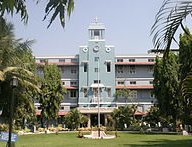
In years gone by the Christian Medical College (CMC) Hospital, Vellore, in South India made the final, definitive diagnosis in many difficult medical cases referred from Nepal. For example, a patient from Shanta Bhawan Hospital( now, Patan Hospital) would be diagnosed with probable lung cancer. And if the patient could afford the trip to the CMC Hospital, the diagnosis would be confirmed or refuted. This CMC Hospital continues to play this important role, but now there are many other hospitals in Nepal and India that vie for these Nepali patients. Clearly the treatment at CMC Hospital is characterized by competence, cost effectiveness, and compassion, three important hospital features to consider for any patient seeking treatment for a life-threatening illness. This hospital now has expanded to become a leading health center in India. For example, it boasts a microbiology (study of pathogens such as bacteria, viruses, fungus) department second to none in India. It can arguably be said that microbiology in South Asia is one of the most neglected areas in medicine. For many reasons, many doctors practicing in South Asia are unable to rely on microbiology but prescribe drugs empirically based on clinical history and examination. This prescription may often be adequate, but in certain situations knowing a suspected organism’s sensitivity or resistance to a particular drug can be vital, especially when one is dealing with “killer” bugs like mycobacterium tuberculosis. Hospitals like the well-appointed Hinduja hospital in Mumbai too boast a reliable microbiology laboratory, but the costs are exorbitant. New, modern Nepali hospitals with state- of- the art microbiology are being established, but it will be a while before we reach the excellence level that CMC Hospital displays in many departments including microbiology.
Dr Ida Scudder, a young American missionary doctor started the CMC hospital in the early 1900s. Her story is intriguing because she came from a line of medical missionaries to South India, but in the beginning she herself wanted no part in continuing this family tradition. One day while visiting her doctor father in South India, the husbands of three pregnant patients refused to show their wives to the male doctor (her father), and tragically the three women died of obstructed labour( a present-day, well known cause of death in Nepal) and birth complications that night. After this incident she was so motivated to help that she returned to the United States, became a doctor from Cornell University in 1899 and returned to establish the CMC Hospital which continues to serve the medical needs of many patients rich or poor.

Buddha Basnyat MD
Buddha Basnyat, MD, MSc, FACP, FRCP, Director of the Oxford University Clinical Research Unit-Patan Academy of Health Sciences, Kathmandu.
- Altitude Sickness
- Feb 20, 2018
- Post-earthquake Nepal: The Way Forward
- Dec 13, 2015
- The Annapurna Sanctuary
- Nov 29, 2015
- Diarrhea at the Summit
- Nov 08, 2015
- Altitude Sickness ( AMS, HAPE, HACE)
- Oct 15, 2015
















